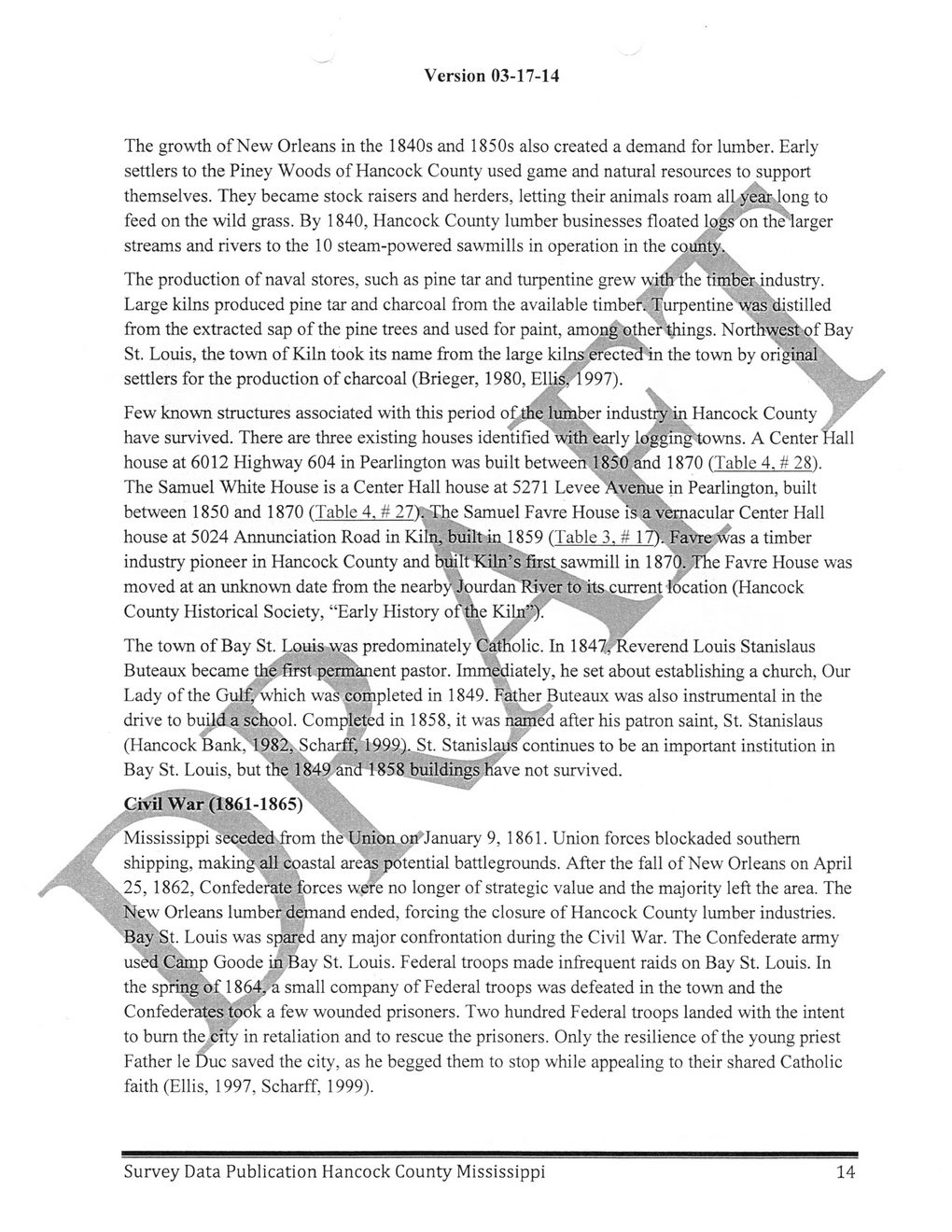This text was obtained via automated optical character recognition.
It has not been edited and may therefore contain several errors.
Version 03-17-14 The growth of New Orleans in the 1840s and 1850s also created a demand for lumber. Early settlers to the Piney Woods of Hancock County used game and natural resources to support . v themselves. They became stock raisers and herders, letting their animals roam all year'long to feed on the wild grass. By 1840, Hancock County lumber businesses floated logs on thelarger streams and rivers to the 10 steam-powered sawmills in operation in the county. The production of naval stores, such as pine tar and turpentine grew with the timber industry. Large kilns produced pine tar and charcoal from the available timber. Turpentine was distilled from the extracted sap of the pine trees and used for paint, among other things. Northwest of Bay ___ v ' \ • \ St. Louis, the town of Kiln took its name from the large kilns erected in the town by original", settlers for the production of charcoal (Brieger, 1980, Ellis, 1997). \ ' N Few known structures associated with this period of the lumber industry‘in Hancock County have survived. There are three existing houses identified with early logging'towns. A Center Hall house at 6012 Highway 604 in Pearlington was built between 1850,and 1870 (Table 4, # 28s). The Samuel White House is a Center Hall house at 5271 Levee Averiue in Pearlington, built between 1850 and 1870 (Table 4. # 27).~The Samuel Favre House is a vernacular Center Hall house at 5024 Annunciation Road in Kiln, built in,1859 (Table 3. # 17). Favre;was a timber industry pioneer in Hancock County and built Kiln’s first sawmill in 1870. ,The Favre House was moved at an unknown date from the nearby Jourdan River to its current location (Hancock County Historical Society, “Early History of the Kiln”): . ‘ '' The town of Bay St. Louis was predominately Catholic. In 1847, Reverend Louis Stanislaus Buteaux became the first permanent pastor. Immediately, he set about establishing a church, Our / • • Lady of the Gulf, which was completed in 1849. Father Buteaux was also instrumental in the drive to build a school. Completed in 1858, it was named after his patron saint, St. Stanislaus (Hancock Bank,' 1982, Scharff, 1999). St. Stanislaus continues to be an important institution in Bay St. Louis, but the 1849 and 1858 buildings have not survived. Civil War (1861-1865) Mississippi seceded from the Union on January 9, 1861. Union forces blockaded southern shipping, making all coastal areas potential battlegrounds. After the fall of New Orleans on April .25, 1862, Confederate forces were no longer of strategic value and the majority left the area. The New Orleans lumber demand ended, forcing the closure of Hancock County lumber industries. Bay St. Louis was spared any major confrontation during the Civil War. The Confederate army used Camp Goode in Bay St. Louis. Federal troops made infrequent raids on Bay St. Louis. In the spring of 1864, a small company of Federal troops was defeated in the town and the Confederates took a few wounded prisoners. Two hundred Federal troops landed with the intent to bum the city in retaliation and to rescue the prisoners. Only the resilience of the young priest Father le Due saved the city, as he begged them to stop while appealing to their shared Catholic faith (Ellis, 1997, Scharff, 1999). Survey Data Publication Hancock County Mississippi 14

Hancock County History and Archeology Survey-Publication-Data-2014-(16)